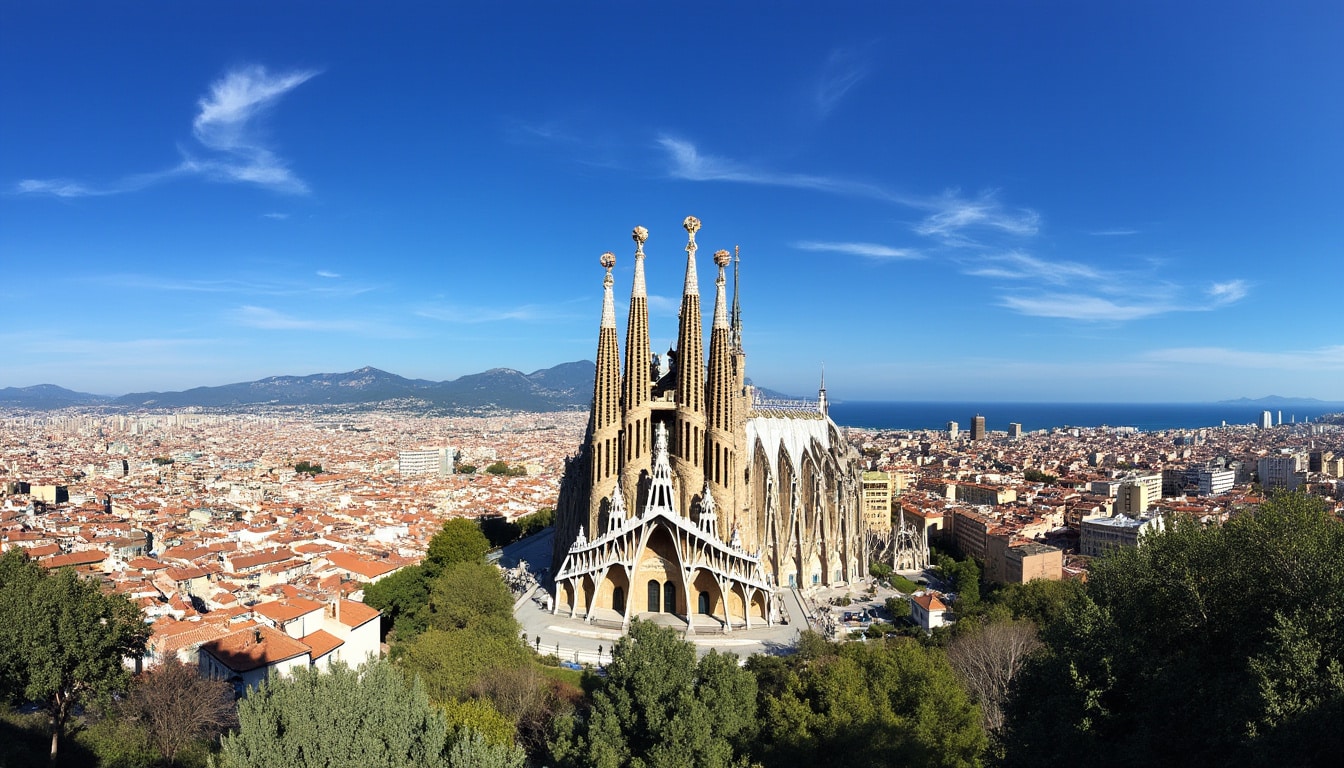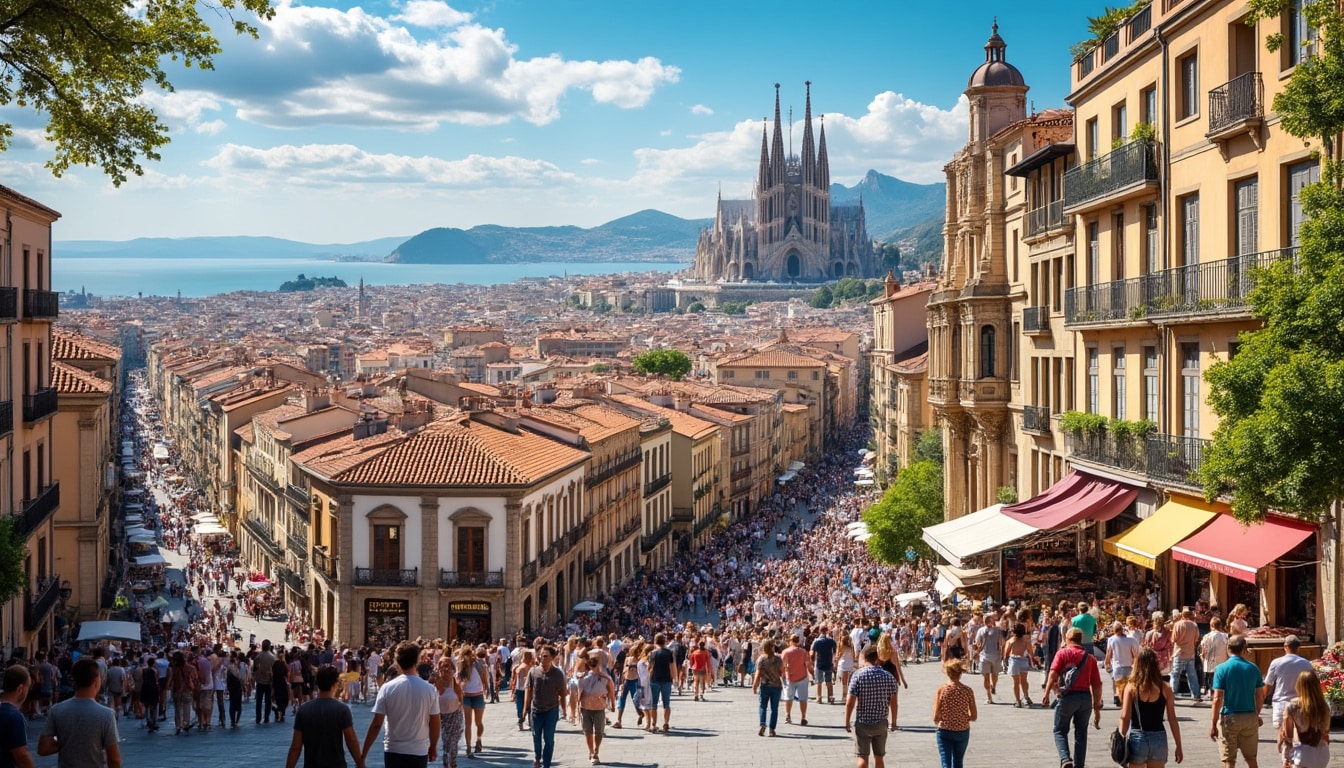Barcelona, a city that dazzles with its rich blend of history, culture, and stunning landscapes, stands as a unique beacon in the heart of Catalonia, Spain. Known for its eclectic architecture, vibrant neighborhoods, and culinary splendor, it’s a city that invites exploration and discovery. The demographics and geography of this dynamic metropolis are as intriguing as its famed Gaudí architecture, shaping the lifestyle and experiences of both residents and visitors alike. This article delves into the multifaceted aspects of Barcelona’s population trends, cultural fabric, and geographic features that make it a captivating destination for millions and a thriving hub on the Mediterranean coast.
Barcelona’s Geographic Landscape: Between Mountains and the Sea
Nestled between the sparkling Mediterranean Sea and the majestic Collserola Mountain range, Barcelona boasts a geographic setting that is nothing short of spectacular. This unique location imbues the city with both natural beauty and strategic importance, influencing everything from its climate to urban development. On the northeastern coast of Spain, Barcelona is bordered by the Besòs and Llobregat rivers, creating a natural framework that supports its thriving urban landscape.
Indeed, the city’s geography is a key component of its identity. With the Pyrenees to the north acting as a natural barrier with France, and the Balearic Sea to the east, it is no wonder that Barcelona has historically been a major trade and cultural exchange hub. The diverse topography of the area has given rise to different neighborhoods, each offering a distinct feel. For example, the Gothic Quarter Tours take visitors through the narrow, winding streets of the oldest part of the city, rich in medieval charm and history.
A closer look at the geography reveals an urban area that sprawls across approximately 101 square kilometers, supporting a vast population center. This expanse includes a mix of plains, hills, and coastal beachfronts that are used for residential, commercial, and recreational purposes. The city’s highest peak, Tibidabo, stands at 1,680 feet, offering breathtaking views and recreational opportunities.
Geographic Features:
- 🏔️ Collserola Mountains – natural backdrop providing hiking trails and green space
- 🌊 Mediterranean coastline – 4.5 km of beaches for sunbathers and watersports enthusiasts
- 🏞️ Rivers & Plains – Besòs and Llobregat rivers offering fertile grounds for lush city parks
Overall, Barcelona’s geographic position enhances its appeal not only as a tourist destination but as a vibrant place for both cultural and economic activities. Whether it’s enjoying the panoramic views from Park Güell or walking along the Barceloneta Beach, the intertwining of geography and lifestyle is evident throughout the city.

The Role of Geography in Urban Development
The interplay between geography and urban development in Barcelona is a testament to its adaptability and forward-thinking urban planning. The city’s geographic constraints have influenced the way buildings are constructed, leading to the innovative architecture for which Barcelona is famous. These constraints are evident in the city’s vertical expansion and the creative use of limited space.
Strategic transport networks, such as the Barcelona Metropolitan Transport system, play a crucial role in connecting various parts of the city. These networks facilitate movement across the geographic barriers, enhancing accessibility and fostering a vibrant metropolitan culture. The focus on sustainable development is also evident in initiatives to increase green spaces and promote eco-friendly transport.
The subtle interweaving of historic preservation with modern expansion ensures that Barcelona continues to thrive while respecting its natural boundaries. The commitment to sustainable urban growth is further illustrated in initiatives like the Superblocks program, designed to reduce traffic and enhance pedestrian spaces. Through thoughtful urban planning that honors its geographic heritage, Barcelona continues to cultivate a vibrant, inclusive environment.
Understanding Barcelona’s Demographic Diversity
As of 2025, Barcelona is home to approximately 5.7 million residents, making it the second-largest city in Spain. The population growth in recent years mirrors the city’s expanding economic and cultural influence, attracting people from across the globe. This diverse demographic mosaic is what makes Barcelona not just a city, but a vibrant community brimming with eclectic influences.
Barcelona’s cultural diversity is one of its defining characteristics, with a population comprising 62% native Catalans and a growing number of international residents. About 24% of the city’s inhabitants hail from various regions of Spain, while a vibrant expatriate community, accounting for over 14% of the population, adds to the cosmopolitan atmosphere. This demographic blend enriches local culture, evident in the city’s diverse culinary offerings and vibrant arts scene.
The city is a melting pot of cultures, each contributing to the rich tapestry of daily life. It’s this diversity that supports a wide range of Barcelona Food Tours, wherein visitors can experience an array of global cuisines alongside traditional Catalan dishes. Such tours often showcase famous foods of Barcelona, reflecting the varied palate that emerges from this multicultural environment.
Demographic Highlights:
- 👫 Major ethnic groups: Catalans, Spaniards, and international communities
- 🏢 High density in urban area with 5.7 million residents
- 🌍 Significant expatriate population contributing to global culture
The continuous influx of people also impacts the housing market, sparking interest in Barcelona Real Estate Services to accommodate the growing demand for residential spaces. While this rapid urbanization presents challenges, it also fosters a rich environment of shared cultural experiences and innovation.
Population Trends and Challenges
The evolution of Barcelona’s population is influenced by a complex interplay of factors, including economic opportunities, lifestyle appeal, and global connectivity. Catalonia Airlines and other international travel options ensure that Barcelona remains a nexus point for global travelers and residents alike.
While the city’s population is steadily increasing, this growth presents both opportunities and challenges. Diverse neighborhoods foster creativity and cultural exchange, yet they also highlight the need for effective urban policy that caters to the broad needs of a varied populace. Issues such as housing affordability, transport access, and resource management are at the forefront of municipal considerations, demanding comprehensive strategies to maintain a high quality of life.
The Cultural Tapestry of Catalan Identity
Barcelona’s identity is deeply rooted in its Catalan heritage, which permeates its culture, language, and traditions. Catalan is the official language, alongside Spanish, and it plays a paramount role in everyday communication. The growing interest in Catalan Culture Experiences showcases the region’s vibrant arts, literature, and traditional festivals.
The celebration of Catalan identity is visible in the Grand Festivals, such as La Mercè and Sant Jordi, which highlight local customs and bring the community together in jubilant celebration. These events offer immersive experiences to both residents and tourists, weaving together performances, parades, and local traditions.
For those keen on exploring more about Barcelona’s rich cultural tapestry, discovering its famous architectural gems is a must. Gaudí Architecture Tours provide a window into the city’s unique style, a combination of Modernism and traditional Catalan influences. These tours highlight iconic landmarks such as the Sagrada Familia and Park Güell, deepening the visitor’s appreciation of Barcelona’s artistic spirit.
Catalan Culture Highlights:
- 🎭 Festivals like La Mercè offering a taste of local tradition
- 🏛️ Architectural wonders reflecting cultural history
- 📚 Catalan language and literature as cultural pillars
This strong sense of cultural identity often poses a juxtaposition with global influences in Barcelona. The city’s dynamic blend of the local and global creates a vibrant synergy that is cherished by all who dwell in or visit this Catalan jewel.
Economic and Social Dynamics Shaping Barcelona
Barcelona’s economic resiliency and innovative spirit contribute significantly to its demographic trends, supporting a population that thrives on diverse industries. Key sectors include tourism, fashion, sports, and technology, each playing an instrumental role in shaping the economic landscape.
The tourism sector, in particular, is a major economic force, supported by a wide array of activities such as the thriving Barcelona Tourism. This industry benefits from the influx of visitors eager to experience the city’s art, food, and vibrant street life. The economy is further buoyed by world-class sporting events, which draw spectators from across the globe.
Similarly, Barcelona Fashion Brands are renowned worldwide, driven by creative talent and innovation that reflect the city’s cutting-edge style. The ongoing evolution of digital startups and tech enterprises in Barcelona’s startup ecosystem also contributes to economic diversification and job creation.
Key Economic Drivers:
- 🏖️ Tourism as a core pillar of the economy
- 🏟️ Sports events enhancing international profile
- 👜 Fashion and creative industries driving innovation
Socially, Barcelona remains a place of progress and innovation. Initiatives such as Barcelona Event Management focus on enhancing community engagement and fostering inclusive growth. As the city navigates its way through the demands of the future, its social dynamics will continue to evolve, drawing on the past yet leaning into what lies ahead.
Educational and Employment Opportunities
Home to several prestigious universities and a thriving startup culture, Barcelona is a hub for education and professional growth. The city hosts numerous conferences and international events, providing platforms for knowledge exchange and networking. These opportunities fuel a vibrant community of young professionals and students, attracted to Barcelona for its dynamic lifestyle and career potential.
Moreover, the synergy between local governments, educational institutions, and businesses fosters an environment conducive to innovation and research. This collaboration enhances Barcelona Real Estate Services, creating spaces that cater to the needs of an evolving demographic landscape.
FAQ
How has Barcelona’s population evolved over the years? Barcelona’s population has seen steady growth, particularly due to its expansive economy, cultural influence, and international connectivity. By 2025, it is estimated at approximately 5.7 million.
What are some landmark geographic sites in Barcelona? Key geographic features include the Collserola Mountains, Tibidabo, and the Mediterranean coast, which offer breathtaking landscapes and recreational opportunities.
How does the cultural diversity of Barcelona enhance the city? The mix of Catalan, Spanish, and international cultures creates a rich tapestry of traditions, languages, and culinary delights, making Barcelona a thriving cosmopolitan city.

